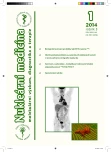Biological testing of antibody IgG M75 labelled by 125I
Authors:
Lenka Marešová 1; Ondřej Lebeda 2; Daniel Seifert 2; Irena Sieglová 3; Vlastimil Král 3
Authors‘ workplace:
ÚJV Řež, a. s.
1; ÚJF AV ČR, v. v. i., Řež
2; ÚMG AV ČR, v. v. i., Praha
3
Published in:
NuklMed 2014;3:2-7
Category:
Original Article
Overview
Introduction:
Radioimmunotherapy belongs to rapidly developing clinical methods. It is often the best therapy option for patients with relapsing lymphoma, or for elderly patients. The development of new types of immunoconjugates has been, therefore, one of the key topics in the development of new radiopharmaceuticals.
Methods:
Immunoglobulin G M75 was labelled via electrophilic iodination method with 125I, a nuclide with optimal properties for development of labelling method and also for the determination the labelled compounds properties (binding activity, immunospecificity). Major advantages of 125I are mainly its long half-life (59,40 days) and low radiation burden. The conjugates were tested for binding activity by ELISA method, the concentration was determined by modified Bradford method. The physiological distribution was tested on CD1-Foxn1nu mice.
Results:
The results show an accumulation of more than 7 % of administered radioactivity in tumour tissue, the binding activity of the antibody determined one day after administration was > 90 % of the non-labelled compound binding activity.
Conclusion:
The prepared radioimmunoconjugate IgG M75 labelled with 125I retains sufficient binding activity, and, therefore, it has potential in therapy of tumors expressing carbonic anhydrase. For the use in radioimunotherapy, it is necessary to test the analogous radioimmunoconjugate labelled with therapeutic radionuclide 131I.
Key words:
IgG M75, antibodies, physiological distribution, 125I, ELISA, CD1-Foxn1nu
Sources
1. Kohler G, Milstein C. Continuous cultures of fused cells secreting antibody of predefined specificity. Nature 1975;256 : 495-497
2. Cwiertka K, Hajdúch M, Trojanec R et al. Terapeutické monoklonální protilátky v onkologii. Klin Farmakol Farm 2004;18 : 165-170
3. De Decker M, Bacher K, Thierens H et al. In vitro and in vivo evaluation of direct rhenium-188-labeled anti-CD52 monoclonal antibody alemtuzumab for radioimmunotherapy of B-cell chronic lymphocytic leukemia. Nucl Med Biol 2008;35 : 599-604
4. Stilleobrer A, Boerman O, Desar I et al. Phase 1 radioimmunotherapy study with lutetium 177-labeled anti-carbonic anhydrase IX monoclonal antibody girentuximab in patiens with advanced renal cell carcinoma. Eur Urol 2013;64 : 478-485
5. Goldsmith S. Radioimmunotherapy of lymphoma: Bexxar and Zevalin. Semin Nucl Med 2010;40 : 122-135
6. Chrastina A, Závada J, Parkkila S et al. Biodistribution and pharmacokinetics of 125I-labeled monoclonal antibody M75 specific for carbonic anhydrase IX, an intrinsic marker of hypoxia, in nude mice xenografted with human colorectal carcinoma. Int J Cancer 2003;105 : 873-881
7. Hyršl L, Závada J, Závadová Z et al. Karbonická anhydráza IX (CA IX) a její exprese u adenokarcinomu ledviny a uroteliálních nádorů močového měchýře. Ces Urol 2011;15 : 85-92
8. Pastoreková S, Závada J. Carbonic anhydrase IX (CA IX) as a potential target for cancer therapy. Canc Ther 2004;2 : 245-262
9. Li Y, Wang H, Oosterwijk E et al. Antibody-specific Detection of CAIX in Breast and Prostate Cancers. Biochem Biophys Res Commun 2009;386 : 488-492
10. De La Mare P. Electrophilic halogenation – 1. vydání. Cambridge Univ. Press, Cambridge, 1976, 231 p
11. Bradford MM. A Rapid and Sensitive Method for the Quantitation of Microgram Quantities of Protein Utilizing the Principle of Protein-Dye Binding. Anal Biochem 1976;72 : 248-254
12. Ye G, Oshins R, Rouhani F et al. Development, validation and use of ELISA for antibodies to human alpha-1 antitrypsin. J Immunol Meth 2013;388 : 18-24
13. Dowall S, Richards K, Graham V et al. Development of an indirect ELISA method for the parallel measurement of IgG and IgM antibodies aganist Crimean-Congo haemorrhagic fever (CCHF) virus using recombinant nucleoprotein as antigen. J Virol Meth 2012;179 : 335-341
14. Ku J, Park J. Biology of SNU Cell Lines. Cancer Res Treat 2005;37 : 1-19
15. Huhtala T, Laakkonen P, Sallinen H at al. In vivo SPECT/CT imaging of human orthotopic ovarian carcinoma xenografts with 111In-labeled monoclonal antibodies. Nucl Med Biol 2010;37 : 957-964
16. Tinianow JN, Gill HS, Ogasawara A at al. Site-specifically 89Zr-labeled monoclonal antibodies for ImmunoPET. Nucl Med Biol 2010;37 : 289-297
17. Schneider D, Heitner T, Alicke B at al. In Vivo Biodistribution, PET Imaging, and Tumor Accumulation of 86Y - and 111In-Antimindin/ RG-1, Engineered Antibody Fragments in LNCaP Tumor-Bearing Nude Mice. J Nucl Med 2009;50 : 435-443
18. Rasaneh S, Rajabi H, Babaei M at al. Radiolabeling of trastuzumab with 177Lu via DOTA, a new radiopharmaceutical for radioimmunotherapy of breast cancer. Nucl Med Biol 2009;36 : 363-369
Labels
Nuclear medicine Radiodiagnostics RadiotherapyArticle was published in
Nuclear Medicine

2014 Issue 1
Most read in this issue
- Seminoma and sarcoidosis – complication of treatment response evaluation with 18F-FDG PET/CT – case report
- Biological testing of antibody IgG M75 labelled by 125I
- Nursing problems in patients during stress tests as a part of myocardial perfusion scintigraphy
- What can you see on the image?
